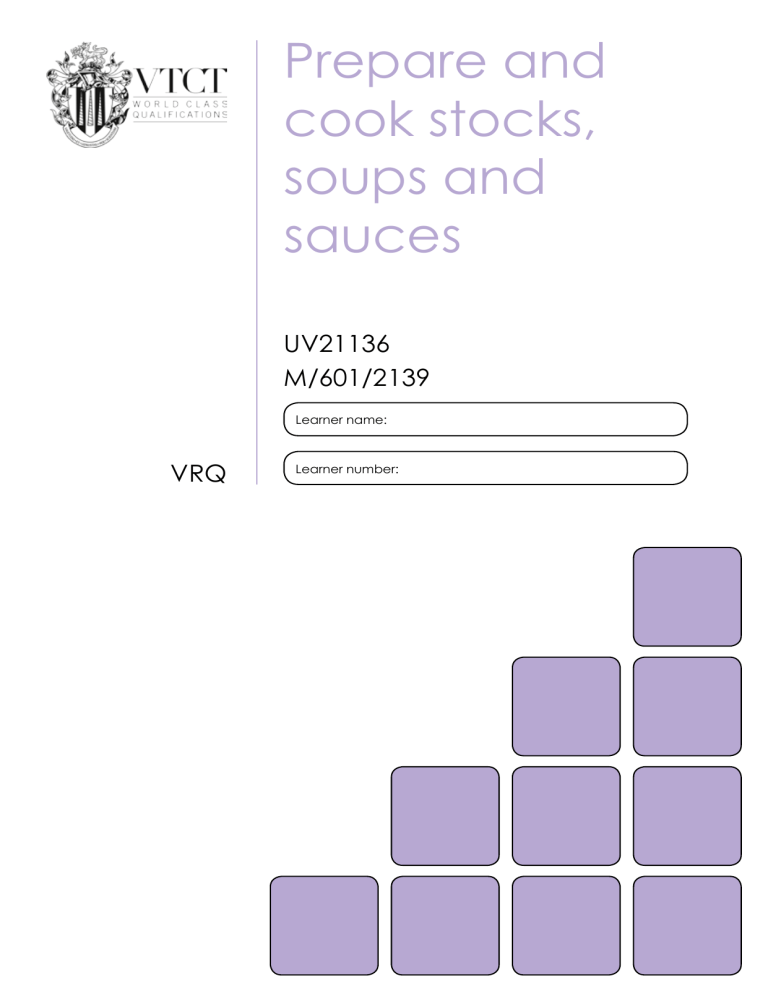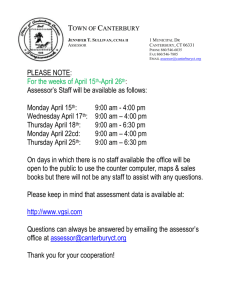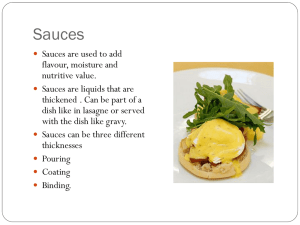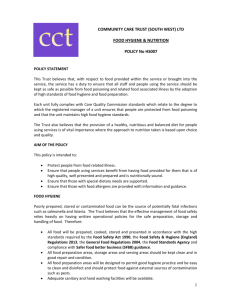Prepare and cook stocks, soups and sauces

Prepare and cook stocks, soups and sauces
VRQ
UV21136
M/601/2139
Learner name:
Learner number:
VTCT is the specialist awarding body for the Hairdressing, Beauty Therapy, Complementary Therapy,
Hospitality and Catering and Sport and Active Leisure sectors, with over 45 years of experience.
VTCT is an awarding body regulated by national organisations including Ofqual, SQA, DfES and CCEA.
VTCT is a registered charity investing in education and skills but also giving to good causes in the area of facial disfigurement.
Statement of unit achievement
By signing this statement of unit achievement you are confirming that all learning outcomes, assessment criteria and range statements have been achieved under specified conditions and that the evidence gathered is authentic.
This statement of unit achievement table must be completed prior to claiming certification.
Unit code Date achieved Learner signature
Assessor initials
IV signature
(if sampled)
Assessor tracking table
All assessors using this Record of Assessment book must complete this table. This is required for verification purposes.
Assessor name Assessor signature
Assessors initials
Assessor number
(optional)
UV21136
Prepare and cook stocks, soups and sauces
The aim of this unit is to develop your knowledge, understanding and practical skills in preparing and cooking stocks, soups and sauces. You will study their quality points and storage requirements.
You will demonstrate how to make a range of different soups which are always a popular menu item, so it is important that they are prepared to a high standard.
You will also be preparing and cooking stocks and sauces which are important in the kitchen because of the way they enhance and complement the flavour of foods.
UV21136_v5
Level
2
Credit value
6
GLH
40
Observation(s)
2
External paper(s)
0
Prepare and cook stocks, soups and sauces
Learning outcomes
On completion of this unit you will:
1. Be able to prepare and cook stocks
2. Be able to prepare and cook soups
3. Be able to prepare and cook sauces
Evidence requirements
1. Environment
Evidence for this unit may be gathered within the workplace or realistic working environment (RWE).
2. Simulation
Simulation may be used in this unit, where no naturally occurring evidence is available.
3. Observation outcomes
Competent performance of Observation outcomes must be demonstrated on at least two occasions . Assessor observations, witness testimonies and products of work are likely to be the most appropriate sources of performance evidence. Professional discussion may be used as supplementary evidence for those criteria that do not naturally occur.
Assessed observations should not be carried out on the same day for the same learning outcome. There should be sufficient time between assessments for reflection and personal development.
You need to meet the same standard on a regular and consistent basis. Separating the assessments by a period of at least two weeks is recommended as competence must be demonstrated on a consistent and regular basis.
4. Range
All ranges must be practically demonstrated or other forms of evidence produced to show they have been covered.
5. Knowledge outcomes
There must be evidence that you possess all the knowledge and understanding listed in the Knowledge section of this unit. In most cases this can be done by professional discussion and/or oral questioning. Other methods, such as projects, assignments and/or reflective accounts may also be used.
6. Tutor/Assessor guidance
You will be guided by your tutor/assessor on how to achieve learning outcomes and cover ranges in this unit. All outcomes and ranges must be achieved.
7. External paper
There is no external paper requirement for this unit.
UV21136 3
Achieving observations and range
Achieving observation outcomes
Your assessor will observe your performance of practical tasks. The minimum number of competent observations required is indicated in the Evidence requirements section of this unit.
Criteria may not always naturally occur during a practical observation. In such instances you will be asked questions to demonstrate your competence in this area. Your assessor will document the criteria that have been achieved through professional discussion and/or oral questioning. This evidence will be recorded by your assessor in written form or by other appropriate means.
Your assessor will sign off a learning outcome when all criteria have been competently achieved.
Achieving range
The range section indicates what must be covered. Ranges should be practically demonstrated as part of an observation. Where this is not possible other forms of evidence may be produced. All ranges must be covered.
Your assessor will document the portfolio reference once a range has been competently achieved.
4 UV21136
Observations
Learning outcome 1
Be able to prepare and cook stocks
You can: a. Demonstrate the correct use of equipment to prepare, cook and store stocks b. Prepare ingredients for making stocks c. Cook different types of stocks (fresh) d. Apply quality points to each stage of the process e. Demonstrate safe and hygienic practices
*
*
May be assessed by supplementary evidence.
Observation
Criteria questioned orally
Date achieved
Portfolio reference
Learner signature
Assessor initials
1 2 Optional Optional
UV21136 5
Learning outcome 2
Be able to prepare and cook soups
You can: a. Demonstrate the correct use of equipment to prepare, cook and store soups b. Prepare ingredients for making soup, according to recipe or dish requirements c. Cook different types of soup d. Demonstrate finishing methods and present with appropriate accompaniments e. Apply quality points to each stage of the process f. Demonstrate safe and hygienic practices
*
6
*
May be assessed by supplementary evidence.
Observation
Criteria questioned orally
Date achieved
Portfolio reference
Learner signature
Assessor initials
1
UV21136
2 Optional Optional
Learning outcome 3
Be able to prepare and cook sauces
You can: a. Demonstrate the correct use of equipment to prepare, cook and store sauces b. Prepare ingredients for making sauces, according to recipe and dish requirements c. Produce different types of sauces d. Demonstrate finishing methods e. Apply quality points to each stage of the process f. Demonstrate safe and hygienic practices
*
*
May be assessed by supplementary evidence.
Observation
Criteria questioned orally
Date achieved
Portfolio reference
Learner signature
Assessor initials
1 2 Optional Optional
UV21136 7
Range
You must practically demonstrate that you have:
Prepared a minimum of 2 types of stock
White
Brown
Fish
Vegetable
Prepared and cooked a minimum of 4 types of soup
Consommé
Potage
Purée
Cream
Velouté
Bisque
Chilled
Used a minimum of 4 finishing accompaniments
Cream
Garnish
Herbs
Butter
Liaison
Croutons or flutes
Cheese
Portfolio reference
Portfolio reference
Portfolio reference
It is strongly recommended that all range items are practically demonstrated. Where this is not possible, other forms of evidence may be produced to demonstrate competence.
8 UV21136
You must practically demonstrate that you have:
Prepared and cooked a minimum of 4 types of sauces
Roast gravy
Béchamel (including derivatives)
Jus lié (including derivatives)
Purée
Reduction
Tomato
Portfolio reference
It is strongly recommended that all range items are practically demonstrated. Where this is not possible, other forms of evidence may be produced to demonstrate competence.
UV21136 9
Developing knowledge
Achieving knowledge outcomes
You will be guided by your tutor and assessor on the evidence that needs to be produced.
Your knowledge and understanding will be assessed using the assessment methods listed below*:
• Projects
• Observed work
• Witness statements
• Audio-visual media
• Evidence of prior learning or attainment
• Written questions
• Oral questions
• Assignments
• Case studies
• Professional discussion
Where applicable your assessor will integrate knowledge outcomes into practical observations through professional discussion and/or oral questioning.
When a criterion has been orally questioned and achieved, your assessor will record this evidence in written form or by other appropriate means. There is no need for you to produce additional evidence as this criterion has already been achieved.
Some knowledge and understanding outcomes may require you to show that you know and understand how to do something. If you have practical evidence from your own work that meets knowledge criteria, then there is no requirement for you to be questioned again on the same topic.
10
*This is not an exhaustive list.
UV21136
Knowledge
Learning outcome 1
Be able to prepare and cook stocks
You can: f. Evaluate the finished product g. Identify different types of stock h. State the uses of stock i. Explain the quality points in preparing and cooking stocks j. Identify the preparation principles for stocks k. Explain why different stocks require different cooking times l. State the cooking times of different stocks m. Identify the cooking and chilling principles for stocks n. Identify correct storage procedures for stocks
Portfolio reference
UV21136 11
Learning outcome 2
Be able to prepare and cook soups
You can: g. Evaluate the finished product h. Identify the different types of soup i. Explain the quality points in preparing and cooking soups j. Identify preparation and cooking principles for soups k. Identify appropriate finishing methods and accompaniments for soups
Portfolio reference
12 UV21136
Learning outcome 3
Be able to prepare and cook sauces
You can: g. Evaluate the finished product h. Identify different types of sauces i. Identify sauce and dish combinations j. Explain the purpose of sauces k. Explain the quality points in preparing and cooking sauces l. Identify the preparation/cooking principles for sauces m. Describe the skills needed to check and finish sauces n. Identify correct storage procedures for sauces
Portfolio reference
UV21136 13
Unit content
This section provides guidance on the recommended knowledge and skills required to enable you to achieve each of the learning outcomes in this unit. Your tutor/assessor will ensure you have the opportunity to cover all of the unit content.
Outcome 1: Be able to prepare and cook stocks
Equipment: Coloured coded boards, knives, stock pot, strainers, pans, storage containers, refrigerator, stove.
Types of stock: White (beef, chicken), brown (beef, chicken, veal), fish, vegetable.
Prepare ingredients: Blanching, browning, bones, vegetables (mirepoix), herbs.
Quality points: Freshness, colour, clarity, free from fat, taste, aroma.
Safe and hygienic practices: Appropriate protective clothing, wash hands regularly, clean and clear working area and tools.
Evaluate the finished product: Colour, clarity, flavour, aroma, seasoning.
Uses of stock: Soups, sauces, cooking liquor.
Preparation principles: Blanching, browning.
Reasons for different cooking times:
Flavour, collagen content, bones used.
Cooking times for different stocks: Fish
30-40 minutes, chicken 3-4 hours, meat 5-8 hours, vegetables 30 minutes.
Cooking and chilling principles:
Simmering, skimming, reducing, blast chilling to below 5ºC.
Storage procedures: Below 5ºC, label with date, stock rotation.
14 UV21136
Outcome 2: Be able to prepare and cook soups
Equipment: Pans, stove, spoons, knives, coloured coded boards, strainers, ladles.
Prepare ingredients: Cutting (meat, vegetables), adding stock.
Different types of soup: Consommé, potage (broth), purée, cream, velouté, bisque, chilled.
Finishing methods and accompaniments: Cream, garnish, herbs, butter, liaison, croutons, flutes, cheese.
Quality points: Freshness, colour, consistency, temperature, appearance, taste, aroma.
Safe and hygienic practices: Appropriate protective clothing, wash hands regularly, clean and clear working area and tools.
Evaluate the finished product: Colour, clarity, flavour, aroma, seasoning.
Preparation and cooking principles:
Cutting (meat, vegetables), sweating, simmering, skimming, blending, straining.
UV21136 15
Outcome 3: Be able to prepare and cook sauces
Equipment: Pans, stove, spoons, knives, coloured coded boards, strainers, ladles.
Prepare ingredients: Cutting (meat, vegetables), adding stock.
Types of sauces: Roast gravy, béchamel derivatives, jus lié derivatives, purée, reductions, tomato.
Finishing methods: Skimming, correct seasoning, check flavour.
Quality points: Freshness, colour, consistency, appearance, taste, aroma, shine.
Safe and hygienic practices: Appropriate protective clothing, wash hands regularly, clean and clear working area and tools.
Evaluate the finished product: Colour, flavour, aroma, seasoning, shine.
Sauce and dish combinations: Roast meats (roast gravy), fish (reductions, batter, tartar, tomato), eggs (béchamel derivatives).
Purpose of sauces: Enhance flavour, complement taste, improve digestion, customer expectations.
Preparation and cooking principles:
Cutting (meat, vegetables), adding stock, reducing, thickening (roux, liaison, cream, butter), simmering, skimming.
Skills needed to check and finish sauces: Adjust consistency (thickening), adjust flavouring, correct seasoning, check temperature.
Storage procedures for sauces: Below
5ºC, label with date, stock rotation.
16 UV21136




